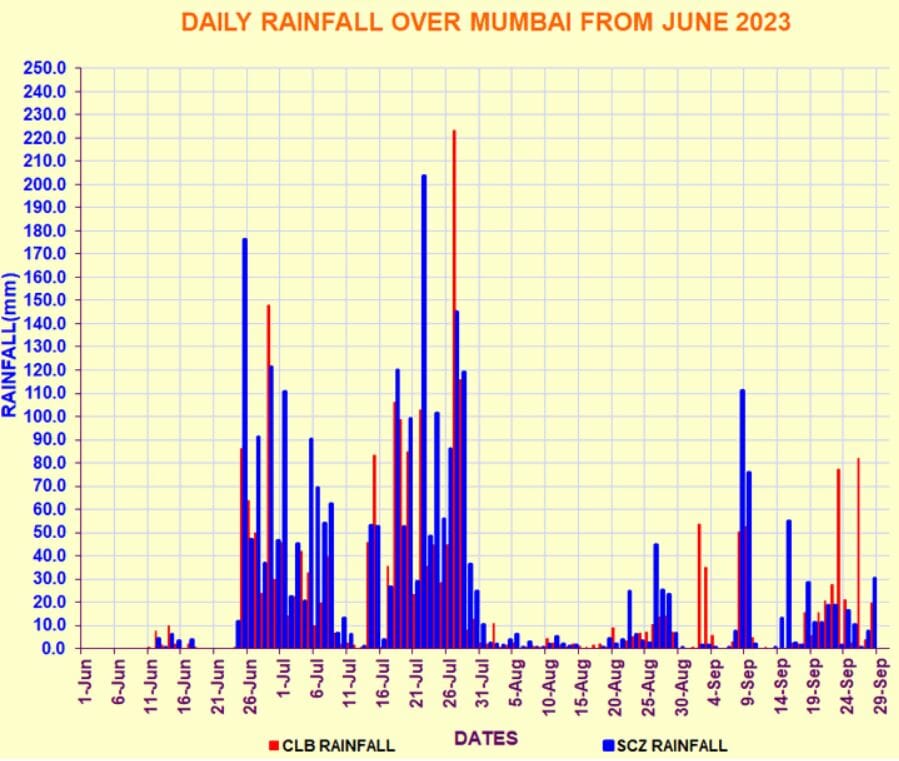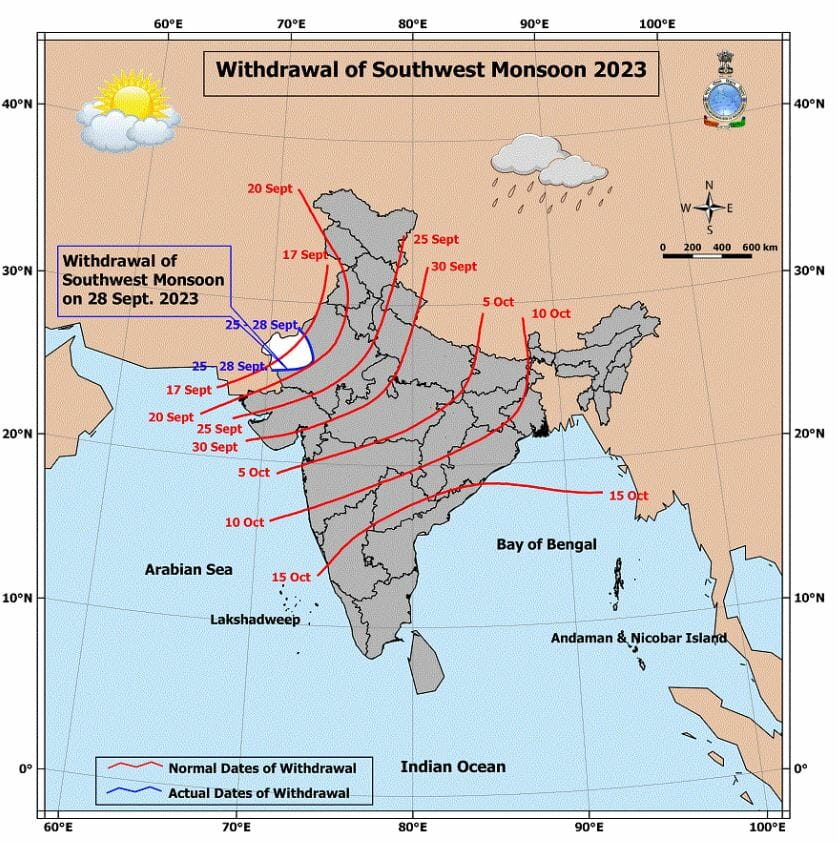As the curtains fall on this year’s monsoon season, let’s take a moment to examine Mumbai’s rainfall performance this year. Due to worries of El Nino, a climate pattern indicating abnormal Pacific Ocean warming, officials anticipated rain deficit. However, contrary to expectations, the weather systems aligned in such a way that Mumbai not only received substantial rainfall but also surpassed its average expectations, experiencing an abundance of rain during the past four months.
Mumbai has received a remarkable 2956.4 mm of rainfall so far, with July marking an all-time high at 1,770 mm. However, the month of August was mostly dry, but September rainfall brought relief to the city, exceeding its average monthly rainfall of 360 mm.
Time and again, climate experts have spoken about changing rainfall patterns because of global warming and other effects of climate change. Extreme rainfall on a few days and dry spells in between has become a pattern over the past few years.
Despite the dry spell in August, the water reserves in Mumbai’s seven lakes reached an impressive 99.6%, equivalent to 14.42 lakh million litres, according to the data released by the Brihanmumbai Municipal Corporation (BMC). This marks the highest water levels in these lakes in the past three years.
So, in all probability there will be no water cuts in the city until next monsoons. Last year, at this time, the water reserves in these lakes were at 98%.

To delve deeper into this year’s monsoon performance in Mumbai, Citizen Matters caught up for a quick conversation with Sushma Nair, an IMD (India Meteorological Department) scientist in Mumbai.

Could you tell us how each month of monsoon went this year?
Each of the four months has shown distinct weather patterns, but as the season concludes, it’s safe to affirm that we’ve not only received ample rainfall but even a slight surplus this year.
Mumbai and Delhi simultaneously experienced their monsoon onset this time. In early June, Cyclone Biporjoy caused a delay in the monsoon onset, nevertheless, within a week of onset, Mumbai received the month’s entire expected rainfall, totalling 549 mm.
In July we witnessed intense rainfall episodes, setting a historic record as the wettest July ever recorded in Mumbai. The city received an astonishing 1,770 mm of rainfall during this month, surpassing even the levels seen during the catastrophic flood year of 2005.

However, the month of August experienced a significant rainfall deficiency, with a – 67% deviation. During this period, Mumbai recorded merely 177mm of rainfall. This dry spell was primarily due to the monsoon trough, which remained positioned at the foothills of the Himalayas. There were no weather systems capable of delivering the much-needed rains, such as a ‘monsoon depression’ (a depression that forms within the monsoon trough resulting in rainfall).
As a result, for most of August, the trough remained stagnant in the Himalayan foothills, leading to a monsoon break across the entire peninsula region. This made it one of the driest August months on record for Mumbai in terms of rainfall.
Meanwhile, September has witnessed consistent and substantial rainfall throughout the month, surpassing the anticipated average monthly rainfall with a recorded total of 420 mm so far.
How did the city receive ample rainfall this year despite El Nino concerns?
El Nino remained in a developing phase throughout the monsoon season. It was initially expected to fully develop by August, but this was delayed until late September. By that time, we were well into the monsoon season, which is why its impact on this year’s rainfall was limited. Towards the end of September, a more developed El Nino emerged, but it was countered by a phenomenon formed in the Arabian Sea called the Indian Ocean Dipole (IOD) which brings rainfall.
When a strong El Nino and a strong IOD occur simultaneously, the El Nino’s influence on the monsoon is less severe than expected. Therefore, this year, we achieved our required rainfall without significant interference from El Nino.
Read more: In photos: Monsoon magic in Mumbai
Any chances of experiencing October heat this year?
We might experience October heat this year, as the prevailing weather conditions seem favourable. Last year, we didn’t encounter significant October heat due to elevated moisture levels in the atmosphere until mid-October. Additionally, it was a La Nina year, resulting in less heat. However, this year, if the monsoon withdraws in the first week of October, we could get a few weeks of October heat.

When do we expect the monsoon withdrawal this year?
Currently, the city is experiencing intense thunderstorm activities but they will remain brief as it is often associated with the monsoon’s retreating phase. Last year the monsoon retreat went up to October 26 due to thunderstorms but that may not be the case this year.
The monsoon has already started withdrawing from Rajasthan and its nearby regions. The anticipated withdrawal window for Mumbai is typically between October 5 and October 10, although an official withdrawal date hasn’t been confirmed yet.
Overall monsoon has provided more than enough rainfall, ensuring a sufficient water supply for the people of Mumbai this year.
Citizens can check for latest weather updates on IMD’s website and X (Twitter) handle:
Website :
https://mausam.imd.gov.in/mumbai/
Twitter:
India (@Indiametdept)
Mumbai (@RMC_Mumbai)